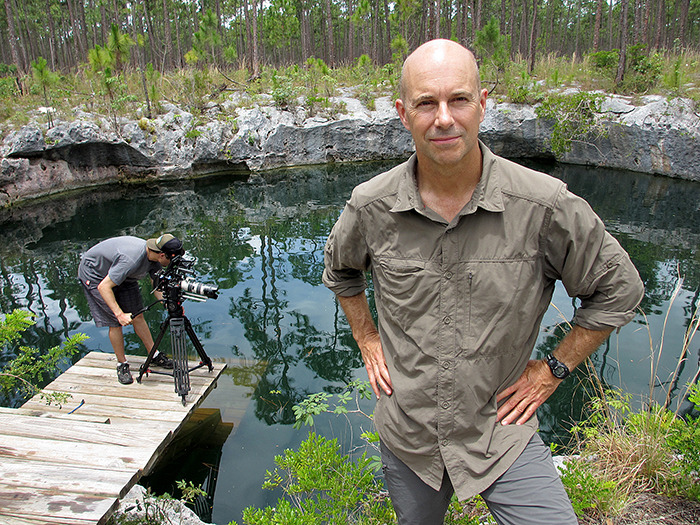Peter Zuccarini, Underwater Camera Operator/DOP on 3D projects including Pirates of the Caribbean: On Stranger Tides, and the upcoming Underworld Awakening details his experiences filming Dolphin Tale 3D… stereoscopic gear, impressions on set, and the magical world of aquatic 3D.
A 3D Tale
Most of the story takes place in the aquarium where Winter the dolphin lives full time. The main character, Sawyer, ends up getting, sort of pulled into the water by Winter and they develop this special relationship. They needed some angles both daytime and nighttime in 3D of those two sort of playing around. My involvement in the beginning of the film was operating a 3D camera in the water. After principal photography they were doing a final sequence that involved integrating some animated dolphins into 3D plates that were shot in the ocean. I was the director of photography for the Caymen Islands unit that did those 3D plates – flying a 3D camera through tunnels and caverns and things like that to develop like a natural world that dolphins would swim through.
Changing gears
As you know, digital cameras for motion pictures are evolving pretty rapidly. At the time there weren’t enough Epics out yet, and the Alexa wasn’t available yet, so we were using a Red One with a Mysterium-X chip and then it was on the Paradise FX beam splitter rig. For the 3D plates we also used the Paradise FX beam splitter rig on that and then we also used a 2D Red underwater system so that we could get into some tighter tunnels at higher speeds to get dolphin POVs, which were then converted.
Pirates (of the Caribbean) was shot on PACE rigs. We didn’t have any underwater housings that fit a PACE rig, so we put it in a simple water box. On Underworld they’re using Epics. And it seems like the next couple features I’m talking to will be shot with the Alexa.
Going under
One of the things that’s interesting about shooting 3D underwater is the sort of atmospheric particles that are suspended in water. In some filming you might almost consider a nuisance to have bubbles floating up through the frame or a little but of dirt flying through the air, but in 3D it sort of ends up being able to be incorporated as atmospheric layers of depth. Little bubbles floating up through the frame gives the stereographer an opportunity to play around with at what point the subject, the boy or the dolphin, get to come out from the screen or reseed back into the screen. Having all of those suspended moving particles gives a really nice opportunity for playing around with people’s perspectives. If you’re shooting through air, you’re deciding where to pull the characters and objects through the frame but in water, it’s almost like the medium itself, the liquid actually ends up offering stereography opportunities. With Dolphin Tale, I found the stereographer got really excited about this. We started deliberately featuring some bubbles as part of the atmosphere.
One of the things I also found really interesting – not technical but more creative – was handling of the light shafts in 3D. When light enters water through a surface, and gets refracted or magnified, and you can play around with how those get positioned. A field of them can be quite three-dimensional, almost like a forest of light beams. In 2D I don’t think they’re nearly as profound.
In suspense
One thing that was interesting about filming the dolphin in its actual habitat was its weightlessness. The dolphin itself was a great 3D subject because you can have it isolated from its surroundings so you can really experiment where you put it in relation to the screen. If you have a talking head, of a person, it’s problematic to pop out because it sheds its stuff on the bottom of the frame. But dolphins suspended in water with no real reference, you can kind of do anything you want with it. Meaning, if you don’t have anything overlapping the sides of the dolphin, you can pull it out into the audience really effectively, without being covered by edge violations. You can even have him swim out into the audience and back away. It really lent itself to nice 3D moments.
Any time you have fish or floating objects like that you have a lot more opportunity to push the 3D. When we shot the plates in Caymen Islands we had schools of fish, and in one shot in particular in the title sequence we had a sea turtle. We were filming down a crevasse and this little sea turtle came and sort of did like a 180 looking at us, and then looking past us, just sort of suspended in the water in front of the camera. That shot, turned into composite of dolphins whizzing by one after another through the crevasse looking down into the coral landscape, makes it look like he was watching the dolphins go by.
The final word
The thing about water is the weightlessness … you’re not bound by gravity. In 3D, you can get a lot of different perspectives of a subject and its movements. It’s immersive – it really allows you to share the experience.

